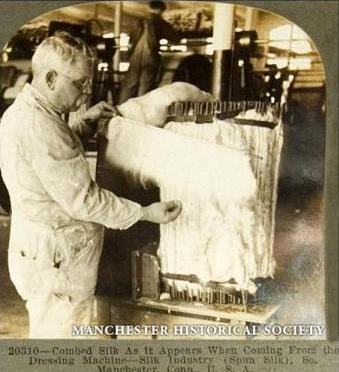



Silk Industry (Spun Silk), So. Manchester, Conn., U.S.A.
The workman in this picture is holding up a stick carrying silk fibres which have been passed once around the cylinder as explained in the last view. One end has been combed. It will now be replaced in the machine so that the uncombed end will be exposed to the action of the combing needles when the "dressing" or combing process will be completed.
The fibres thus combed out in the dressing machine are of various lengths. The longest, of course, are the most valuable. The material combed out from the first draft of longest fibres may be "dressed" still further, so as to give a second draft of combings, which naturally are shorter. In fact, five or six different lengths of these combings may be obtained. The short fibre thus obtained is known as "noil."
This "noil" yarn made, as just described, from the waste silk combings after they have gone through the various cleaning and dressing operations will, in the nature of the case, contain more nibs and dust than the better yarns. Hence the finished "noil" yarn will be more bumpy and in consequence, of somewhat inferior quality.
Behind the stick of partially combed silk can be seen a bundle of sticks carrying the silk fibres which have not yet been combed. These uncombed sticks show very readily the specks of broken chrysalis and other foreign matter which it is necessary to remove.

 )
)